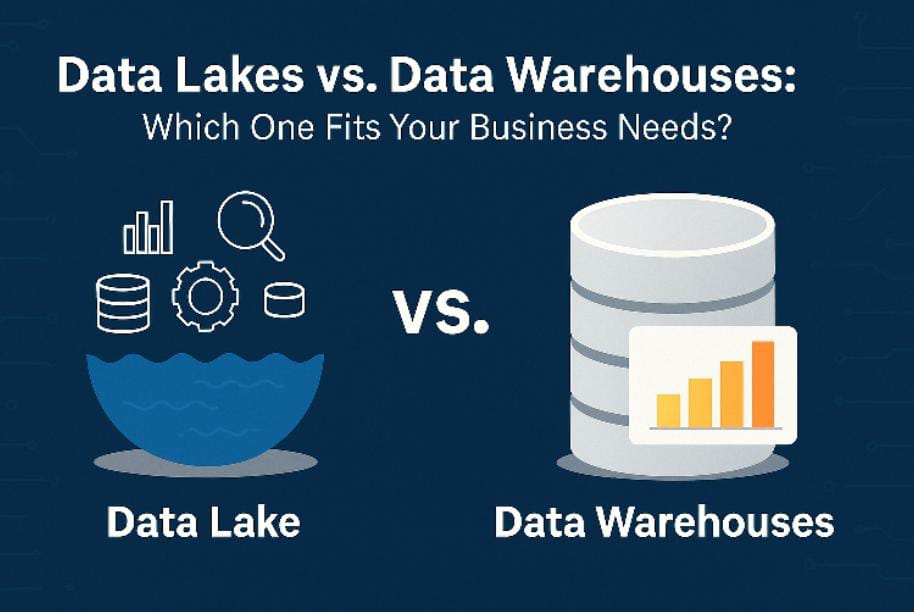In today’s digital economy, data has become one of the most valuable assets for businesses. From customer behavior insights to real-time operational trends, organizations rely on data to make faster, smarter decisions. But not all data is the same and neither are the systems that store it. Companies are often faced with a crucial choice: should they invest in a data lake or a data warehouse?
This decision can shape how effectively they analyze information, control costs, and scale their operations. By understanding the differences between these two approaches and how they align with business goals, leaders can ensure their data strategy supports long-term growth. With the right big data analytics service, the path to smarter decision-making becomes clearer.
Understanding the Basics of Data Storage
What Is a Data Lake?
A data lake is a centralized storage system that holds vast amounts of raw, unstructured, and structured data. Think of it as a massive reservoir where data flows in from multiple sources such as applications, IoT devices, customer touchpoints, and more, without needing to be organized first. This makes data lakes highly flexible, enabling companies to capture information in its original form and later apply analytics as needed.
Because data lakes can store everything from text files and images to real-time streams, they’re often favored by businesses that need agility. Teams working with machine learning, predictive modeling, or advanced big data analytics services often turn to data lakes for their ability to handle large, varied datasets.
What Is a Data Warehouse?
A data warehouse, on the other hand, is more structured. It organizes data into predefined formats, making it easier to query and generate reports. Instead of storing raw data, warehouses process and clean information before it’s stored, ensuring consistency and reliability.
This makes data warehouses the go-to solution for businesses that rely on historical analysis, compliance-driven reporting, and quick access to clean, structured insights. Finance teams, marketing departments, and operations managers often prefer data warehouses because they deliver precise answers to well-defined business questions.
Key Differences Between Data Lakes and Data Warehouses
Data Structure and Flexibility
The most obvious difference lies in how each system treats data. A data lake accepts everything structured, semi-structured, and unstructured data in its raw form. This makes it flexible and future-proof, especially for companies experimenting with machine learning or new business models. A data warehouse, however, requires data to be structured and processed before it can be stored. This “schema-on-write” approach ensures reliability but limits flexibility.
Storage Costs
When it comes to storage, data lakes are generally more cost-effective. They use low-cost systems to store huge volumes of raw data. Data warehouses, however, involve higher costs because of the preprocessing, structured storage, and computing resources needed to maintain performance. Businesses with tight budgets but growing data needs may prefer data lakes, while those prioritizing accuracy and reporting speed may accept higher costs for data warehouses.
Scalability and Performance
Data lakes scale almost effortlessly, handling petabytes of data without breaking a sweat. However, performance can sometimes lag when querying unstructured information. Warehouses, in contrast, are optimized for speed and efficiency in running complex queries. They are ideal for companies where decision-makers need quick, precise insights without wading through messy datasets.
Use Cases
Data lakes shine in scenarios like real-time analytics, IoT data processing, and advanced machine learning. They provide the raw fuel for innovation, enabling data scientists to experiment with new models. Data warehouses, on the other hand, excel in traditional business intelligence (BI). They provide reliable reports, dashboards, and compliance documentation, making them indispensable for industries like finance, healthcare, and retail.
Benefits of Data Lakes
Flexibility for Innovation
Data lakes allow organizations to store all types of data from raw sensor feeds to social media posts without restrictions. This flexibility supports innovation, as businesses can later decide how to structure and analyze the information when new needs or technologies emerge.
Cost-Effective Scaling
Because data lakes use inexpensive storage solutions, they are highly cost-efficient for companies handling massive amounts of information. This makes them especially attractive for industries where data grows rapidly, such as e-commerce, logistics, or IoT-driven businesses.
Advanced Analytics and AI Support
Data lakes serve as the perfect foundation for advanced analytics and machine learning. Data scientists can mine raw data to build predictive models, identify new trends, and uncover insights that structured systems might overlook.
Benefits of Data Warehouses
Reliable and Consistent Data
Data warehouses are designed to provide clean, processed, and structured information. This consistency ensures that business leaders can trust the accuracy of reports and dashboards, making them vital for decision-making and compliance reporting.
Optimized for Speed
Warehouses are built to handle complex queries with high performance. Executives and analysts can quickly generate insights without worrying about delays, which is critical in industries where real-time decisions drive revenue.
Business Intelligence Integration
Data warehouses integrate seamlessly with popular BI tools. This makes it easier for non-technical teams to visualize and understand data, helping organizations democratize insights across departments.
How to Choose the Right Solution
Assess Business Goals
The first step is identifying what the business wants to achieve with its data. If the primary goal is advanced analytics, predictive modeling, or AI-driven insights, a data lake may be the right choice. If the focus is on tracking KPIs, financial reporting, or compliance, a data warehouse provides more structure and reliability.
Consider Data Variety and Volume
Companies generating diverse and unstructured data such as clickstreams, IoT feeds, or multimedia files will benefit from the flexibility of a data lake. In contrast, businesses dealing mainly with structured transactional records or customer databases may lean toward a data warehouse.
Evaluate Budget and Resources
Data lakes are typically cheaper to store but require more investment in data governance and skilled professionals. Data warehouses, while more expensive upfront, offer ready-to-use solutions for reporting and BI, often saving time and effort for business users.
Think About Scalability and Future Growth
Organizations expecting rapid growth in data volume or wanting to experiment with emerging technologies like AI and machine learning should consider data lakes. For companies prioritizing stability and long-term consistency in reporting, data warehouses remain the safer bet.
Seek Expert Guidance
Partnering with a big data analytics service provider, such as those offered by Zchwantech, can help businesses navigate this choice. With expertise in both architectures, these services assess unique needs and design hybrid or tailored solutions that balance flexibility and structure.
Hybrid Approaches: Getting the Best of Both Worlds
Why a Hybrid Model Makes Sense
For many businesses, the choice doesn’t have to be strictly between a data lake or a data warehouse. A hybrid model allows them to store raw, unstructured data in a lake while funneling cleansed and structured data into a warehouse for reporting. This approach gives organizations the flexibility to innovate while still maintaining accuracy for business intelligence.
How It Works in Practice
Data Ingestion: All data, structured or unstructured, first flows into the data lake.
Data Processing: Advanced analytics tools or machine learning models can operate on this raw data.
Data Structuring: Relevant, cleaned, and transformed data is then pushed into the warehouse.
Business Use: Executives, managers, and teams access the warehouse for easy reporting and dashboards, while data scientists and analysts explore the lake for deeper insights.
Real-World Industry Examples
E-commerce: Retailers capture clickstream data, customer behavior, and purchase history in a data lake. Sales trends and revenue reports are then generated from the warehouse.
Healthcare: Hospitals store diverse medical imaging, sensor data, and patient logs in a data lake. For compliance and billing, structured records go into the warehouse.
Finance: Banks collect transaction logs, fraud detection signals, and chat interactions in a data lake. For regulatory reporting, consolidated numbers sit in the warehouse.
The Role of Big Data Analytics Service Providers
By combining the two systems, businesses often face challenges with integration, governance, and cost optimization. This is where Big Data Analytics Service providers like Zchwantech step in. They design custom hybrid solutions that streamline data flow, ensure compliance, and maximize value from both structured and unstructured data.
Choosing the Right Path for Your Business
When it comes to managing data, there’s no one-size-fits-all answer. Data lakes offer flexibility and innovation, while data warehouses provide structure and reliability. Many businesses are now finding success with a hybrid approach that balances the strengths of both.
The key is understanding business needs whether the focus is on predictive analytics, compliance-driven reporting, or scaling for future growth. With the right strategy, companies can transform raw data into actionable insights that drive smarter decisions and long-term success.
For organizations exploring their next step, expert guidance can make all the difference. Zchwantech’s big data analytics service helps businesses design solutions that are secure, scalable, and tailored to their goals. Ready to find out which solution fits your business best? Reach out today at sales@zchwantech.com and start unlocking the full potential of your data.

